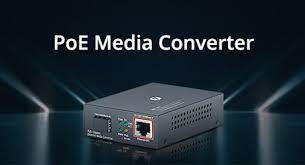PoE (Power over Ethernet) media converters are essential pieces of equipment for any business looking to reap the benefits of PoE technology. Not only do they make it easier to install, manage and configure devices, but they also can help you save money and resources. However, not everyone is familiar with what PoE media converters can do for them. In this guide, we’ll cover everything you need to know about these handy tools so you can make an informed decision when the time comes. From how PoE works to the various types of PoE media converters out there, you’ll be ready to take advantage of all their features in no time.
What is a PoE Media Converter?
A PoE media converter is a device that helps you connect your PoE-enabled devices to a non-PoE network. It essentially allows you to use your existing Ethernet cabling to connect devices that would normally require a separate power source. This can be extremely helpful if you’re trying to save money or space in your office.
There are two main types of PoE media converters: those that support 802.3af and those that support 802.3at. The former is the most common type and is compatible with most PoE-enabled devices. The latter, however, offers more power and is therefore better suited for high-powered devices such as IP cameras.
When shopping for a PoE media converter, it’s important to make sure that it’s compatible with the type of devices you want to connect. Most converters will have this information listed in the product description. Additionally, it’s always a good idea to check with the manufacturer to be absolutely sure.
The Different Types of PoE Media Converters
PoE media converters provide Power over Ethernet to devices that require it, such as IP cameras, VoIP phones, and Access Points. There are different types of PoE media converters available on the market depending on the requirements of the device being powered.
Passive PoE: This type of PoE requires a separate power supply to be connected to the media converter in order to function. It is typically used for lower powered devices that do not require a lot of power, such as WiFi Access Points.
Active PoE: Active PoE injects power directly into the Ethernet cable, eliminating the need for a separate power supply. It can be used for devices that require more power, such as IP cameras or VoIP phones.
High Power Over Ethernet (HPoE): HPoE is a new standard that allows for up to 60 watts of power to be delivered over an Ethernet cable. It is designed for use with high-powered devices such as 4K cameras or virtual reality headsets.
Pros and Cons of a PoE Media Converter
There are several benefits that come along with using a PoE media converter. One of the most notable advantages is that it can help to reduce the overall cost of your network infrastructure. By using this type of device, you will be able to deliver both power and data over a single Ethernet cable. This can save you money on both installation and operational costs.
In addition, a PoE media converter can also help to simplify your network setup. This is because you will not need to worry about running separate power cables to each individual device. Instead, all of the devices on your network can be powered through the use of a single Ethernet cable. This can make your network much easier to manage and maintain.
However, there are also some potential drawbacks associated with using a PoE media converter. One potential issue is that this type of device can introduce latency into your network. Latency is the amount of time that it takes for data to travel from one point to another on your network. If you have devices that are located far apart from each other, then you may experience increased latency when using a PoE media converter.
Another potential issue is that this type of device can cause electrical interference. If you are using aPoE media converter in an environment where there is already electrical noise present, then you may find that the performance of your network suffers as a result. In some cases, this interference can even cause complete outages on your network.
How to Use a PoE Media Converter
A PoE media converter can be a useful tool for anyone who wants to connect two devices that use different types of media. For example, you may want to connect a computer to a TV or an Ethernet connection to a Wi-Fi router.
There are a few things to keep in mind when using a PoE media converter:
1. Make sure that the PoE media converter is compatible with the devices you’re trying to connect.
2. If you’re connecting a device that uses power over Ethernet (PoE), make sure that the PoE media converter supports PoE.
3. Connect the devices you want to connect to the PoE media converter using the appropriate cables. For example, use an HDMI cable to connect a computer to a TV.
4. Once everything is connected, turn on the devices and follow any instructions provided by the manufacturer of the PoE media converter.
Conclusion
PoE media converters provide a convenient and cost-effective way to extend your network with devices that are powered by PoE. With these versatile devices, you can connect your existing Ethernet infrastructure to PoE-powered equipment such as IP cameras and access points. They also offer additional features such as Power over Coax or Long Reach Mode, making them an ideal choice for a variety of applications. We hope this article has helped you better understand what PoE media converters are capable of doing for you and why they should be part of your networking strategy.

